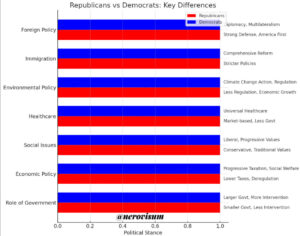Unraveling the differences between Red-Republicans and Blue-Democrats in the United States
By: Brandon Lewis
The main difference between Republicans and Democrats in the United States lies in their core political ideologies, policy preferences, and views on the role of government. Here are some key distinctions:
1. Role of Government:
- Republicans: Generally advocate for a smaller federal government with limited intervention in the economy and individual lives. They emphasize personal responsibility, free-market capitalism, and reducing taxes and government spending.
- Democrats: Typically support a larger role for the federal government in addressing social issues, regulating the economy, and providing public services. They advocate for policies that promote social welfare, environmental protection, and economic equality.
2. Economic Policy:
- Republicans: Favor lower taxes, deregulation, and policies that they believe will stimulate business growth and entrepreneurship. They often prioritize reducing the national debt and balancing the federal budget.
- Democrats: Support progressive taxation (where the wealthy pay a higher percentage) to fund social programs, education, healthcare, and infrastructure. They tend to focus on reducing income inequality and ensuring economic opportunities for all citizens.
3. Social Issues:
- Republicans: Tend to hold more conservative views on social issues, advocating for traditional values. They may oppose abortion, support gun rights, and prioritize law and order.
- Democrats: Often embrace more progressive or liberal positions on social issues, supporting reproductive rights (including access to abortion), stricter gun control, LGBTQ+ rights, and criminal justice reform.
4. Healthcare:
- Republicans: Generally prefer a market-based healthcare system with less government involvement, opposing large-scale government-run programs like universal healthcare.
- Democrats: Typically support expanding government involvement in healthcare, including programs like the Affordable Care Act (Obamacare), and many advocate for universal healthcare or Medicare for All.
5. Environmental Policy:
- Republicans: Often prioritize economic growth and energy independence, sometimes questioning the extent of human impact on climate change and advocating for less restrictive environmental regulations.
- Democrats: Usually emphasize the importance of addressing climate change through government intervention, supporting renewable energy initiatives, and enacting environmental protections.
6. Immigration:
- Republicans: Tend to favor stricter immigration policies, stronger border security, and measures to reduce illegal immigration.
- Democrats: Generally advocate for comprehensive immigration reform, including a pathway to citizenship for undocumented immigrants and more lenient policies towards refugees and asylum seekers.
7. Foreign Policy:
- Republicans: Often support a strong national defense, military intervention when necessary to protect U.S. interests, and an “America First” approach in international relations.
- Democrats: Typically favor diplomacy, multilateralism, and working with international organizations to address global issues. They may be more cautious about military intervention.
These are broad generalizations, and there is a wide range of views within each party. Additionally, positions can evolve over time and vary depending on the specific issue or context.






